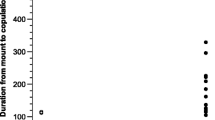Abstract
The lifetime mating frequency of female butterflies is believed tobe dependent on the reproductive status of the males which they have mated. This report assesses those status usingPieris rapae L. Multiple mating females mated males with a short time interval after the last mating or males with many mating records. Such males, like small ones, produced small spermatophores during copulation, which may have resulted in high mating frequency of those females. The males with short time interval after the last mating or those with many mating records also showed a long mating duration. Alternative interpretations of the adaptive significance of this behavior for males are discussed.
Similar content being viewed by others
References
Boggs, C. L. (1981a) Selection pressures affecting male nutrient investment at mating in Heliconiine butterflies.Evolution 35: 931–940.
Boggs, C. L. (1981b) Nutritional and life-history determinants of resource allocation in holometabolus insects.American Naturalist 117: 692–709.
Boggs, C. L. (1990) A general model of the role of male-donated nutrients in female insect's reproduction.American Naturalist 136: 598–617.
Boggs, C. L. and L. E. Gilbert (1979) Male contribution to egg production in butterflies: Evidence for transfer of nutrients at mating.Science 206: 83–84.
Boggs, C. L. and W. B. Watt (1981) Population structure of pierid butterflies. IV. Genetic and physiological investment in offspring by maleColias.Oecologia 50: 320–324.
Burns, J. M. (1968) Mating frequency in natural populations of skippers and butterflies as determined by spermatophore counts.Proceedings of the National Academy of Sciences of the USA 61: 852–859.
Drummond III, B. A. (1984) Multiple mating and sperm competition in the Lepidoptera. pp. 291–370.In R. L. Smith (ed.),Sperm competition and the evolution of animal mating systems. Academic Press, Orlando.
Ehrlich, A. H. and P. R. Ehrlich (1978) Reproductive strategies in the butterflies: I. Mating frequency, plugging, and egg number.Journal of Kansas Entomological Society 51: 666–697.
Forsberg, J. and C. Wiklund (1989) Mating in the afternoon: Timesaving in courtship and remating by females of a polyandrous butterflyPieris napi.Behavioral Ecology and Sociobiology 25: 349–356.
Gossard, T. and R. E. Jones (1977) The effects of age and weather on egglaying inPieris rapae.Journal of Applied Ecology 14: 65–71.
Gwynne, D. T. (1984) Male mating effort, confidence of paternity, and insect sperm competition. pp. 117–149.In R. L. Smith (ed.)Sperm competition and the evolution of animal mating systems. Academic Press, Orlando.
Kaitala, A. and C. Wiklund (1994) Polyandrous female butterflies forage for matings.Behavioral Ecology and Sociobiology 35: 385–388.
Kaitala, A. and C. Wiklund (1995) Female mate choice and mating costs in the polyandrous butterflyPieris napi (Lepidoptera: Pieridae).Journal of Insect Behavior 8: 355–363.
Oberhauser, K. S. (1988) Male monarch butterfly spermatophore mass and mating strategies.Animal Behavior 36: 1384–1388.
Oberhauser, K. S. (1989) Effects of spermatophores on male and female monarch butterfly reproductive success.Behavioral Ecology and Sociobiology 25: 237–246.
Perker, G. and L. Simmons (1989) Nupital feeding in insects: Theoretical models of male and female interests.Ethology 82: 3–26.
Pliske, T. E. (1973) Factors determining mating frequencies in some New World butterflies and skippers.Annals of the Entomological Society of America 66: 165–169.
Rutowski, R. L. (1979) The butterfly as an honest salesman.Animal Behavior 27: 1269–1270.
Rutowski, R. L., G. W. Gilchrist and B. Terkanian (1987) Female butterflies mated with recently mated males show reduced reproductive output.Behavioral Ecology and Sociobiology 20: 319–322.
Sugawara, T. (1979) Stretch reception in the bursa copulatrix of the butterfly,Pieris rapae crucivora, and its role in behaviour.Journal of Comparative Physiology 130: 191–199.
Suzuki, Y. (1979) Mating frequency in females of the small cabbage white,Pieris rapae crucivora Boisduval (Lepidoptera: Pieridae).Kontyû 47: 335–339.
Svard, L. and C. Wiklund (1986) Different ejaculate delivery strategies in the first versus subsequent matings in a swallowtail butterflyPapilio machaon.Behavioral Ecology and Sociobiology 18: 325–330.
Svard, L. and C. Wiklund (1988) Fecundity, egg weight, and longevity in relation to multiple mating in females of the monarch butterfly.Behavioral Ecology and Sociobiology 23: 39–43.
Watanabe, M. (1988) Multiple matings increase the fecundity of the yellow swallowtail butterfly,Papilio xuthus, in summer generations.Journal of Insect Behavior 1: 17–30.
Watanabe, M. and S. Ando (1993) Influence of mating frequency on lifetime fecundity in wild females of small whitePieris rapae (Lepidoptera: Pieridae).Japanese Journal of Entomology 61: 691–696.
Watanabe, M. and S. Ando (1994) Egg load in wild females of the small whitePieris rapae crucivora (Lepidoptera: Pieridae) in relation to mating frequency.Japanese Journal of Entomology 62: 293–297.
Wiklund, C. and J. Foresberg (1991) Sexual size dimorphism in relation to female polygamy in butterflies: a comparative study of Swedish Pieridae and Satylidae.Oikos 60: 373–381.
Wiklund, C., A. Kaitala, V. Lindfors and J. Abenius (1993) Polyandry and its effect on female reproduction in the green-veined white butterfly (Pieris napi L.).Behavioral Ecology and Sociobiology 33: 25–33.
Author information
Authors and Affiliations
Rights and permissions
About this article
Cite this article
Kandori, I., Ohsaki, N. Male mating behavior in relation to spermatophore transfer in the white cabbage butterfly. Res Popul Ecol 38, 225–230 (1996). https://doi.org/10.1007/BF02515731
Received:
Accepted:
Issue Date:
DOI: https://doi.org/10.1007/BF02515731




